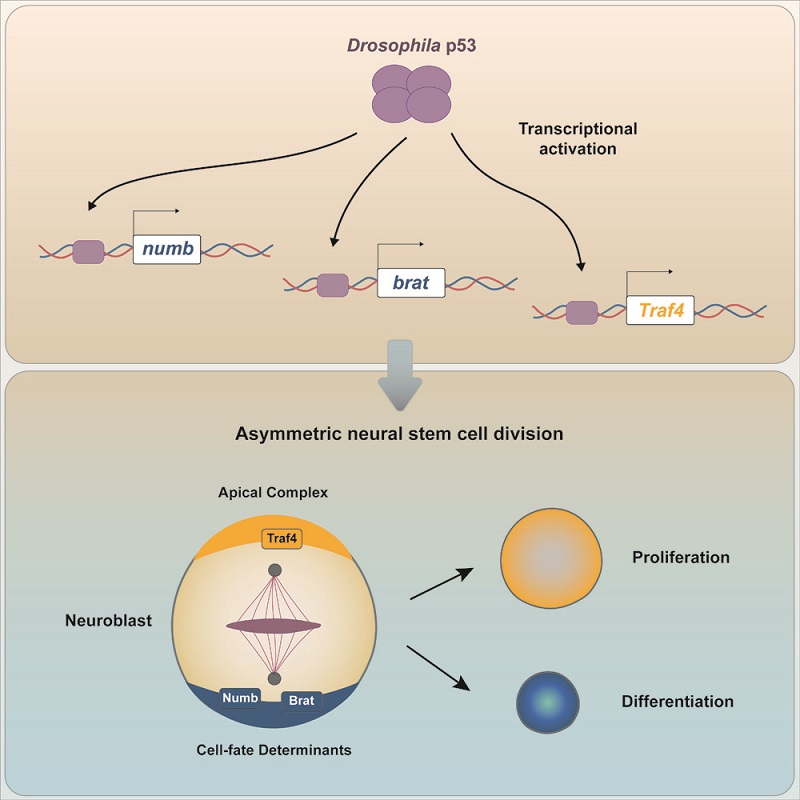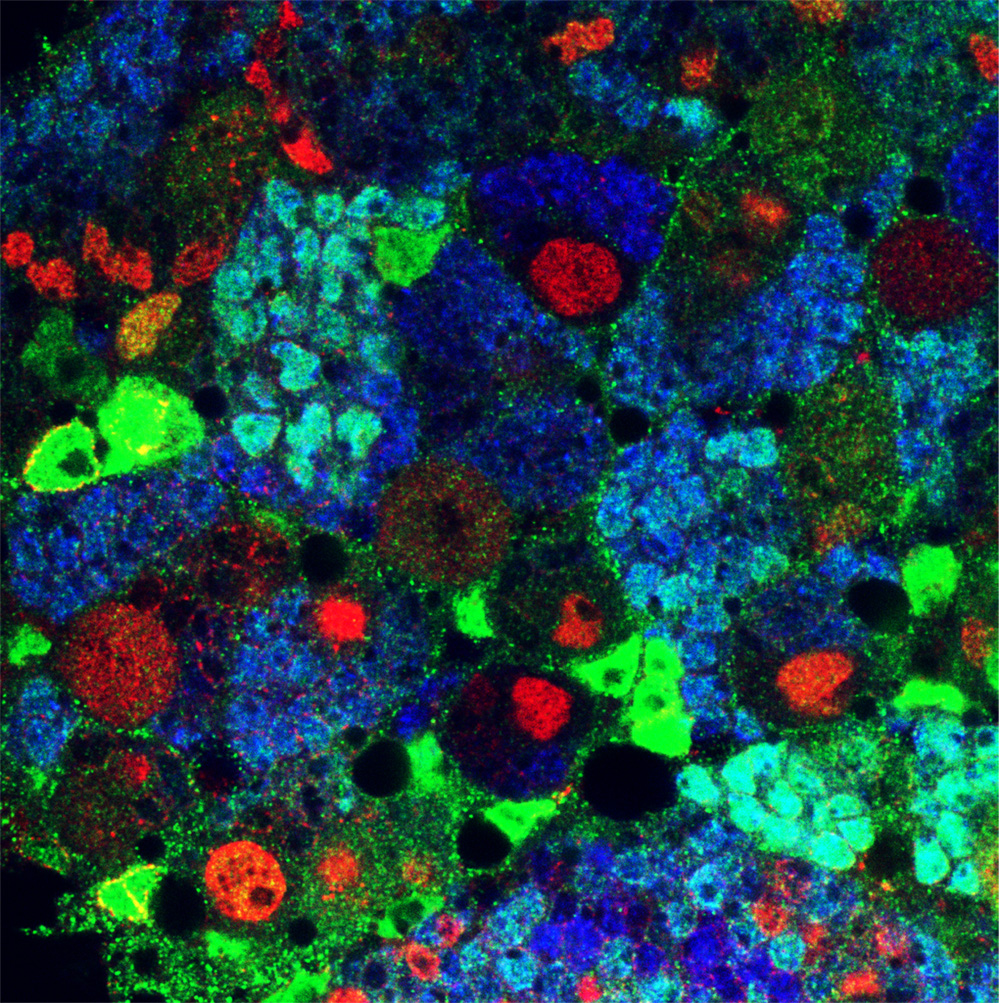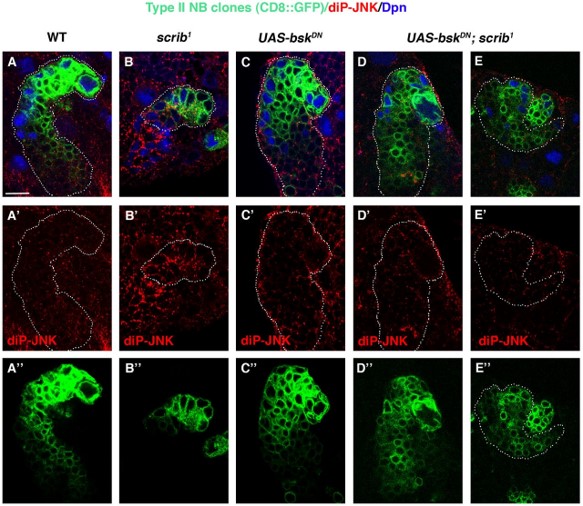Lines of investigation
One of the big challenges in Developmental Neurobiology is to understand how the immense variety of neural types that constitute the nervous system is generated. Asymmetric cell division is a universal and key mechanism to generate cell diversity during Development, and it is also an important process in Cancer and Stem Cell Biology. Our lab is currently focused on analyzing in depth this process both during development and in tumorigenesis. The aim of our research is to unveil the functional signaling networks underlying the autonomous and non-autonomous mechanisms that regulate asymmetric cell division. In this context, we consider PDZ (PSD-95, Dlg, ZO-1) domain-containing proteins, including the proteins Canoe/Afadin and Scribble, excellent candidates as hubs of cross-talk between signaling pathways during this process. We achieve our research combining Genetic, Cell Biology, Biochemistry, Molecular Biology and Proteomic techniques.
Specifically, we are interested in studying and contributing to answering three fundamental questions in the field:
1.- Which are mechanisms that regulate the asymmetry of the division to finally render two different daughter cells? Our model system for answering this question are the embryonic and larval neuroblasts, the neural stem cells of the Drosophila central nervous system.
2.- Which are the mechanisms that control the “switch” between a symmetric to an asymmetric mode of cell division? Our model system for answering this question is the “Optic Lobe of the Drosophila larval brain”.
3.- Which are the connections between asymmetric cell division and tumorigenesis? Our model system are the type II neuroblasts of the Drosophila larval brain.
Representative Publications
- Drosophila p53 tumor suppressor directly activates conserved asymmetric stem cell division regulators. Sandra Manzanero-Ortiz, Maribel Franco, Mahima Laxmeesha, Ana Carmena iScience. 2024 Volume 27, Issue 11 - Open access https://doi.org/10.1016/j.isci.2024.111118
- Glial-secreted Netrins regulate Robo1/Rac1-Cdc42 signaling threshold levels during Drosophila asymmetric neural stem and progenitor cell division. Ana de Torres-Jurado, Sandra Manzanero-Ortiz, Ana Carmena Current Biology. 2022 32(10): 2174-2188.e3 https://doi.org/10.1016/j.cub.2022.04.001
- Pilot RNAi Screen in Drosophila Neural Stem Cell Lineages to Identify Novel Tumor Suppressor Genes Involved in Asymmetric Cell Division Manzanero-Ortiz S, de Torres-Jurado A, Hernández-Rojas R, Carmena A Int J Mol Sci 2021 22(21):11332 https://doi.org/10.3390/ijms222111332
- Eph signaling controls mitotic spindle orientation and cell proliferation in neuroepithelial cells Franco M, Carmena A Journal of Cell Biology 2019 218(4):1200 https://doi.org/10.1083/jcb.201807157
- Synergism between canoe and scribble mutations causes tumorlike overgrowth via Ras activation in neural stem cells and epithelia Rives-Quinto N, Franco M, de Torres-Jurado A, Carmena A Development 2017 144(14):2570 https://doi.org/10.1242/dev.148171
- The Hippo Pathway Core Cassette Regulates Asymmetric Cell Division Keder A, Rives-Quinto N, Aerne BL, Franco M, Tapon N, Carmena A Curr Biol 2015 25(21):2739 https://doi.org/10.1016/j.cub.2015.08.064
- Drosophila p53 tumor suppressor directly activates conserved asymmetric stem cell division regulators. Sandra Manzanero-Ortiz, Maribel Franco, Mahima Laxmeesha, Ana Carmena iScience. 2024 Volume 27, Issue 11 - Open access https://doi.org/10.1016/j.isci.2024.111118
- Glial-secreted Netrins regulate Robo1/Rac1-Cdc42 signaling threshold levels during Drosophila asymmetric neural stem and progenitor cell division. Ana de Torres-Jurado, Sandra Manzanero-Ortiz, Ana Carmena Current Biology. 2022 32(10): 2174-2188.e3 https://doi.org/10.1016/j.cub.2022.04.001
- Non-muscle myosin II activation: adding a classical touch to ROCK Carmena A Small GTPases 2021 12(3):161 https://doi.org/10.1080/21541248.2019.1671148
- Pilot RNAi Screen in Drosophila Neural Stem Cell Lineages to Identify Novel Tumor Suppressor Genes Involved in Asymmetric Cell Division Manzanero-Ortiz S, de Torres-Jurado A, Hernández-Rojas R, Carmena A Int J Mol Sci 2021 22(21):11332 https://doi.org/10.3390/ijms222111332
- The Case of the Scribble Polarity Module in Asymmetric Neuroblast Division in Development and Tumorigenesis Carmena A Int J Mol Sci 2020 21(8):2865 https://doi.org/10.3390/ijms21082865
- Eph signaling controls mitotic spindle orientation and cell proliferation in neuroepithelial cells Franco M, Carmena A Journal of Cell Biology 2019 218(4):1200 https://doi.org/10.1083/jcb.201807157
- Eph signaling in mitotic spindle orientation: whats your angle here? Franco M, Carmena A Cell Cycle 2019 18(20):2590 https://doi.org/10.1080/15384101.2019.1658479
- Measurement of Mitotic Spindle Angle and Mitotic Cell Distance in Fixed Tissue of Drosophila Larval Brains Franco M, Carmena A Small GTPases 2019 9(22):e3432 https://doi.org/10.21769/BioProtoc.3432
- Non-muscle myosin II activation: adding a classical touch to ROCK Carmena A J Neurosci Methods 2019 12(3):161 https://doi.org/10.1080/21541248.2019.1671148
- Compromising asymmetric stem cell division in Drosophila central brain: revisiting the connections with tumorigenesis Carmena A Fly 2018 12(1):71 https://doi.org/10.1080/19336934.2017.1416277
- Synergism between canoe and scribble mutations causes tumorlike overgrowth via Ras activation in neural stem cells and epithelia Rives-Quinto N, Franco M, de Torres-Jurado A, Carmena A Development 2017 144(14):2570 https://doi.org/10.1242/dev.148171
- The Hippo Pathway Core Cassette Regulates Asymmetric Cell Division Keder A, Rives-Quinto N, Aerne BL, Franco M, Tapon N, Carmena A Curr Biol 2015 25(21):2739 https://doi.org/10.1016/j.cub.2015.08.064
- A Serrate-Notch-Canoe complex mediates glial-neuroepithelial cell interactions essential during Drosophila optic lobe development, Perez-Gomez R, Slovakova J, Rives-Quinto N, Krejci A, Carmena A J Cell Sci 2013 126(21):4873 https://doi.org/10.1242/jcs.125617
- Cytoplasmic protein motility and polarized sorting during asymmetric cell division Keder A, Carmena A Wiley Interdiscip Rev Dev Biol 2013 2(6):797 https://doi.org/10.1002/wdev.116
- A big new job for small GTPases Carmena A Small Gtpases 2012 3(3):159 https://doi.org/10.4161/sgtp.19631
- The Actin-Binding Protein Canoe/AF-6 Forms a Complex with Robo and Is Required for Slit-Robo Signaling during Axon Pathfinding at the CNS Midline Slovakova J, Speicher S, Sanchez-Soriano N, Prokop A, Carmena A J Neurosci 2012 32(29):10035 https://doi.org/10.1523/JNEUROSCI.6342-11.2012
- Canoe functions at the CNS midline glia in a complex with Shotgun and Wrapper-Nrx-IV during neuron-glia interactions Slovakova J, Carmena A Development 2011 138(8):1563 https://doi.org/10.1242/dev.056192
- The Rap1-Rgl-Ral signaling network regulates neuroblast cortical polarity and spindle orientation Carmena A, Makarova A, Speicher S J Cell Biol 2011 195(4):553 https://doi.org/10.1083/jcb.201108112

 Español
Español


